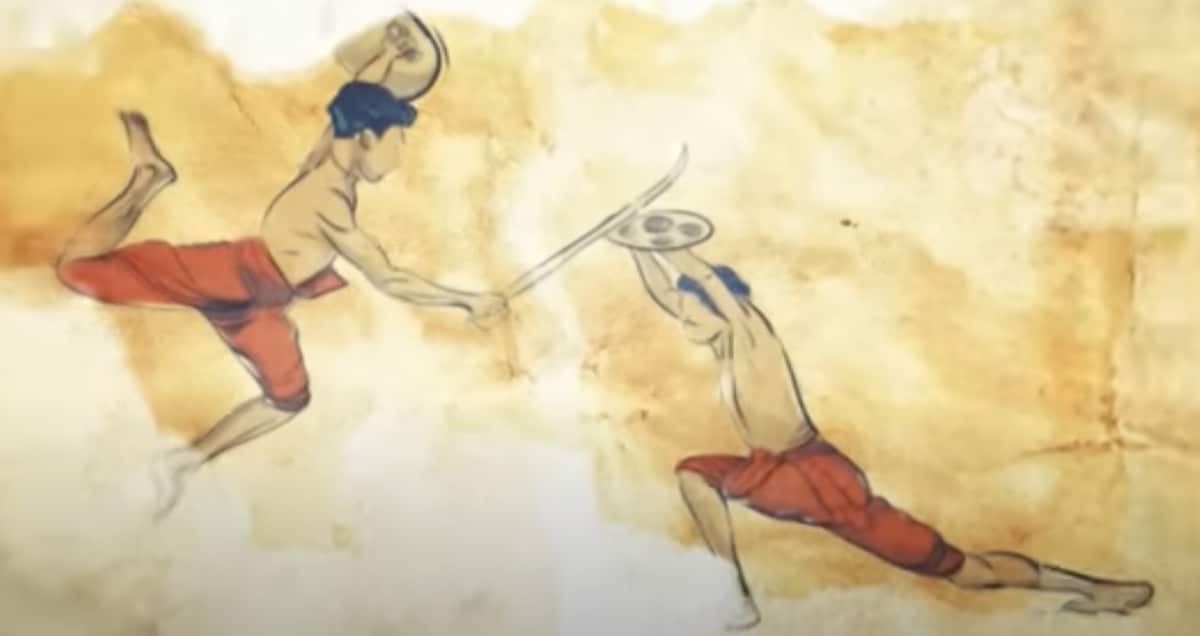Kalaripayattu, the ancient martial art of Kerala, India, is a testament to the enduring legacy of physical prowess, cultural heritage, and historical evolution. Rooted in both legend and historical documentation, Kalaripayattu’s journey through time reveals its profound impact on martial arts globally.
Legend envelops Kalaripayattu’s origins in mysticism and history. According to folklore, sage Parasuramam – an avatar of Vishnu, received the art from Adiyogi Shiva and imparted it to the people of Kerala, shaping its roots with divine lineage. Ayyappa, a war deity, is also revered in some narratives for his connection to Kalaripayattu, reinforcing its mystical underpinnings.
Kalaripayattu enhances mental focus and concentration through its holistic approach, integrating physical training with meditation and mental discipline. The practice fosters single-pointed focus (Ekagrata) through rigorous training, employing meditation to sharpen mental clarity, enhance attention control, and cultivate the ability to quiet the mind. This regimen modifies brain patterns, reducing distractions and heightening awareness. As a result, Kalaripayattu practitioners develop elevated concentration, precision, mindfulness, and mental resilience, enabling them to approach any challenge with confidence and vigilance. Traditional training methods challenge the body to surpass its limits through sheer mental fortitude, achieving mastery of the body through the mind and refining focus, precision, and energy regulation.
Historically, Kalaripayattu finds its earliest substantiated roots in ancient palm leaf manuscripts dating back to around 200 BCE in Kerala. These manuscripts depict fighters in combat, in control of their breathing processes, providing tangible evidence of their existence during that era; as one of the oldest surviving martial arts globally, Kalaripayattu’s foundations are deeply intertwined with the Sangam period’s Tamil combat traditions and the martial practices of Dhanur Vedic traditions introduced by Brahmins from the 7th century CE onward.
The feudal era marked Kalaripayattu’s peak in Kerala, flourishing from the 11th to the 18th centuries. Essential training for warriors serving rival Chera and Chola kingdoms engaged in frequent conflict, Kalaripayattu thrived and spread across Kerala, with legendary accounts establishing 108 principal training grounds or Kalaris. However, British colonial rule in India heralded a period of suppression for Kalaripayattu. Following the Pazhassi Raja’s (head of the Kottayam Kingdom) rebellion in 1804, the British authorities banned the Indian martial art by 1805. Kalaripayattu, the ancient martial art from Kerala, India, faced a ban during the 19th-century British colonial rule due to it being seen as a political threat, enabling rebellion and resistance against the colonial forces, as well as misconceptions and prejudice from the British authorities who misunderstood its rituals and philosophies.
These factors led to its suppression through harsh measures such as confiscating weapons, arresting instructors, and burning down schools, despite which it survived through the efforts of dedicated practitioners who continued to teach it in secret or under disguise. Despite malicious attempts to eradicate it, Kalaripayattu persisted clandestinely through dedicated masters who preserved its techniques and traditions, though much remains lost.
Time has witnessed a remarkable revival of Kalaripayattu in the 20th century. Renowned Gurukkals like C.V. Narayanan Nair and Chirakkal T. Sreedharan Nair played pivotal roles in documenting and revitalizing the ancient martial art form. Meenakshi Amma Gurukkal, a prominent figure since the mid-20th century, further contributed to its preservation and promotion.
Geographically, Kalaripayattu manifests in distinct regional styles across Kerala. Vadakkan Kalari is in the north and is known for its graceful and flexible movements. Thekkan Kalari in the south emphasized hard, impact-based techniques and hand-to-hand combat. Thulunadan Kalari in the Tulu region is characterized by its less widespread practice than the northern and southern styles. Each style reflects cultural nuances and geographical diversity, enriching Kalaripayattu’s multifaceted heritage.
Beyond its geographical boundaries, Kalaripayattu’s influence extends globally, particularly in modern martial arts. It is widely regarded as a progenitor of Asian martial arts such as Kung Fu, Karate, and Taekwondo. The legend of Bodhidharma transmitting Kalaripayattu-derived techniques to the Shaolin monks in China highlights its foundational role in developing Shaolin Kung Fu and other Chinese martial arts. The principles of animal-inspired movements (similar to Yoga), physical conditioning, weapon mastery, breath control, and healing techniques found in Kalaripayattu have permeated these arts, shaping their philosophies and methodologies.
Kalaripayattu’s journey from mystical origins through feudal prominence, colonial suppression, and 20th-century revival exemplifies its resilience and enduring cultural significance across Asia. As an ancient martial art, it continues to inspire and influence diverse martial traditions globally, bridging the ancient with the contemporary in a testament to human ingenuity and physical prowess.
Image: Google
